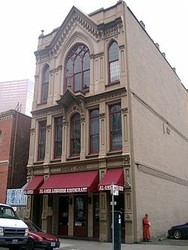Bishop's House
Introduction
Text-to-speech Audio
Images
Bishop's House today (wikimedia commons)

Backstory and Context
Text-to-speech Audio
It is believed that the San Franciscan architect P. Heurn designed the building. Also known for designing the nearby Roman Catholic Cathedral in 1878 – the first of the city – Heurn designed the Bishop’s House in a Victorian Gothic style. Construction was completed in 1879. The three story structure is made of brick and cast iron, with narrow pointed arches, intricate window tracery, and an emphasis on the use of tall, vertical, straight lines in the façade. It has a sharply pointed gable roof (some have compared it with a bishop’s mitre). The third floor has a magnificent cathedral-style window, which lights a large meeting hall within.
Originally adjacent to the Roman Catholic Cathedral, the building initially served as the home and office of Archbishop Francois Blanchett. It served as the chancery office for more than thirty years, and housed an insurance agency on the ground floor. It also hosted the Young Men’s Institute and Catholic Library, and later the office of the Catholic Sentinel newspaper. The Cathedral was demolished in 1894 for being too remote for its parishioners, and the Bishop’s House was sold soon after. From that point the Bishop’s House was occupied by a wide variety of tenants. During the prohibition the Bishop’s House was used as a speakeasy (the peep holes of which can still be viewed today).
Portland’s Chinatown was formed in the 1880s, and grew to become the largest in the country despite the 1882 Chinese Exclusion Act. By the end of the nineteenth century the waterfront and Chinatown neighbourhoods were ridden with crime. Illegal opium and gambling dens were disguised as legitimate businesses, and underground parlours were rife with prostitution. Much of this illicit activity was organised by Chinese tongs – secret societies and brotherhoods, some of which had links to gangs that existed in contemporary China. There were many different tongs in Portland, and their relationships between one another were not always amiable, as demonstrated by the violent Tong Wars of the late nineteenth and early twentieth centuries. A network of underground passages allowed them to flee from the occasional police raid. The Bishop’s House is believed to have been used by one such Tong. A direct telephone line connected the tong building with the Police Department (Rees, 1989).
The building remains in a terrific state of preservation. Some modifications were made in 1965 by William Roberts, who installed a fire escape and who replaced the original cross and finials used to decorate the gabled roof. The building currently serves as office spaces and as Al‑Amir, a Lebanese restaurant. It makes a fine spot from which to visit a number of other interesting nearby buildings: the Bickel Building, Chown Building, Haseltine Building, Oregon Marine Building, “Old Spaghetti Factory”, and many more.
